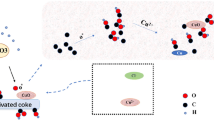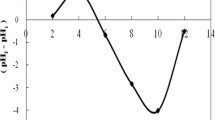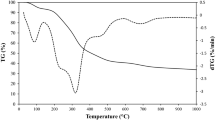Abstract
Nitrogen-enriched activated carbons were prepared from waste medium density fiberboard waste by using NaOH, K2CO3 and KOH. The content of nitrogen in the activated carbon was 0.92, 0.74 and 1.33 % by analysis. The influence of contact time, pH, Cr(VI) initial concentration and the amount of activated carbon on the Cr(VI) adsorption capacity were investigated. The maximum adsorption capacity of Cr(VI) could reach 89.21 mg/g at pH 2 and a contact time of 9 h. The kinetics adsorption followed nicely the pseudo-second-order rate expression. In adsorption isotherm, the Langmuir model fitted better than the Freundlich model. Pure Poplar activated carbon was also prepared as the adsorbent for Cr(VI) removal as control sample. This study indicated that the nitrogen-enriched activated carbon prepared from waste medium density fiberboard can be used effectively for the removal of Cr(VI) compound from aqueous solutions.









Similar content being viewed by others

References
Babel S, Kurniawan TA (2004) Cr(VI) removal from synthetic waste water using coconut shell charcoal and commercial activated carbon modified with oxidizing agents. Chemosphere 54:951–996
Brito F, Ascno J, Mateo S (1997) Equilibrium of Cr(VI) species in acid medium and adsorption studies of these species. Polyhedron 16(21):3835–3846
Cotton FA, Wilkinson GW (1972) Advanced inorganic chemistry, 3rd edn. Wiley, New York, pp 828–833
Dobrowolski R, Otto M (2010) Study of chromium(VI) adsorption onto modified activated carbons with respect to analytical application. Adsorption 16:279–286
Dogan M, Alkan M, Turkyilmaz A, Ozdemir Y (2004) Kinetics and mechanism of removal methylene blue by adsorption onto perlite. J Hazard Mater 109(1–3):141–148
Freundlich H (1906) Über die adsorption in Lösungen (adsorption in solution). Z Phys Chem 57:384–470
Gregg SJ, Sing KSW (1982) Adsorption, surface area and porosity. Academic Press, New York
Ho YS, Ng JCY, Kay MG (2000) Kinetics of pollutant sorption by biosorbents: review. Sep Purif Methods 29:189–232
Iley M, Marsh H, Rodriguez-Reinoso F (1973) The adsorptive properties of carbonized olive stones. Carbon 11:633–636
Lagergren S (1898) Zur Theorie der sogenannten Adsorption gelöster Stoffe. K. Sven. Vetensk. Handl. 24:1–39
Langmuir I (1918) The adsorption of gases on plane surfaces of glass, mica and platinum. J Am Chem Soc 40(9):1361–1368
Liu SX (2005) Removal of chromium (Cr6+) by Ag/TiO2 photocatalysis. Bull Environ Contam Toxicol 74:706–714
Liu SX, Chen X, Chen XY, Liu ZF, Wang HL (2007) Activated carbon with excellent chromium(VI) adsorption performance prepared by acid–base surface modification. J Hazard Mater 141:315–319
Mohan D, Singh KP, Singh VK (2006) Trivalent chromium removal from waste water using low cost activated carbon derived from agricultural waste material and activated carbon fabric cloths. J Hazard Mater 135(1–3):280–295
Smith WA, Apel WA, Petersen JN, Peyton BM (2002) Effect of carbon and energy resource on bacterial chromate reduction. Bioremed J 6(3):205–215
Srivastava SK, Singh AK, Sharma A (1994) Studies on the uptake of lead and zinc by lignin obtaining of black liquor-paper industry waste material. Environ Technol 15(4):353–360
Tazrouti N, Amrani M (2009) Chromium(VI) adsorption onto activated kraft ligin produced from alfa grass. Bioresources 4(2):740–755
WHO (World Health Organization) (1993) Guidelines for drinking-water quality. Recommendations Geneva
Wu Y, Jin XJ, Zhang MY, Xu D (2012) Phenol adsorption on nitrogen-enriched activated carbon from wood fiberboard waste. Wood Fiber Sci 44:220–226
Acknowledgments
The authors are greatly indebted to the State Forestry Administration under Project 201204807: the study on the technology and mechanism of the activated carbon electrode from waste hard board and the project National Natural Science funding: the chemistry mechanism of color system forming during the process of wood heat inducing discolor (31070490).
Author information
Authors and Affiliations
Corresponding author
Additional information
Yu Wu and Ji Zhang contributed equally to this work.
Rights and permissions
About this article
Cite this article
Wu, Y., Zhang, J., Jin, XJ. et al. Study of Cr(VI) adsorption onto nitrogen-enriched activated carbon from waste medium density fiberboard. Wood Sci Technol 48, 713–725 (2014). https://doi.org/10.1007/s00226-014-0632-5
Received:
Published:
Issue Date:
DOI: https://doi.org/10.1007/s00226-014-0632-5



